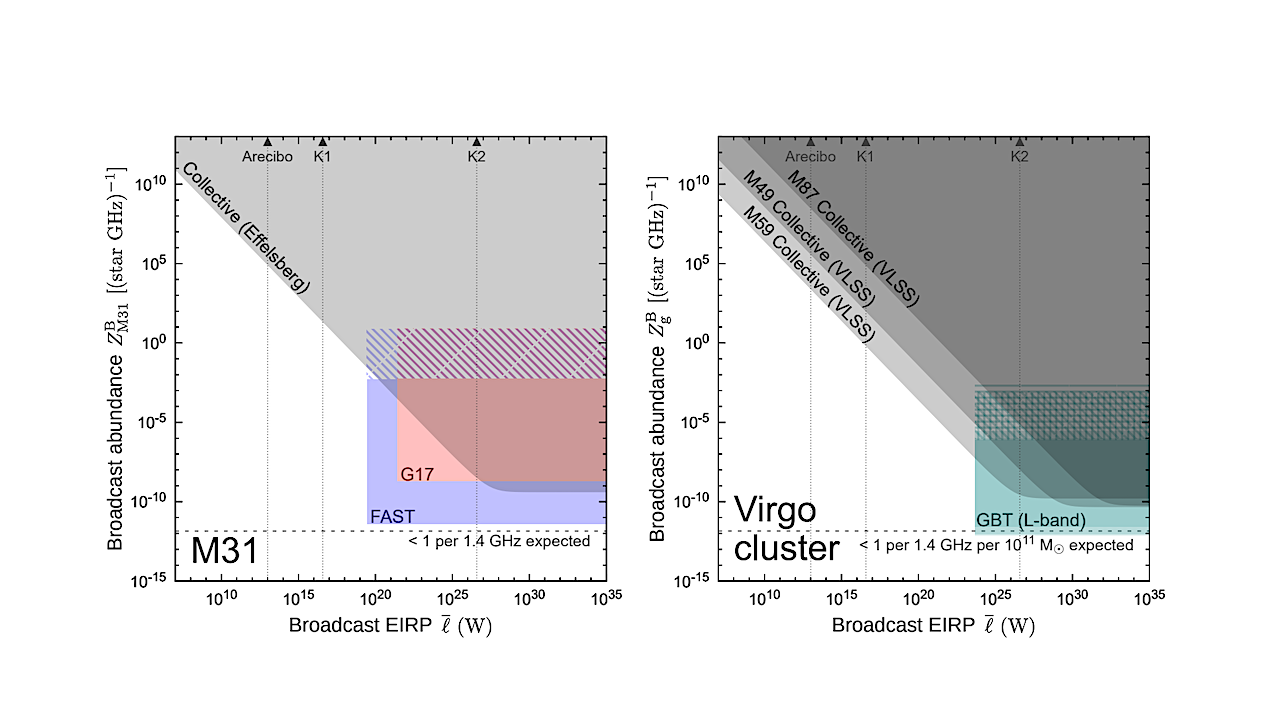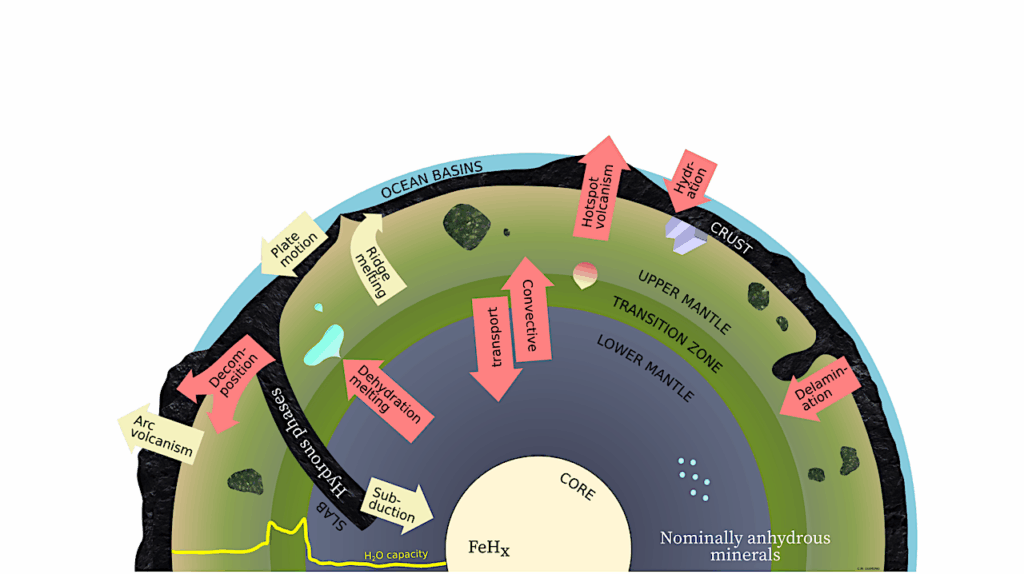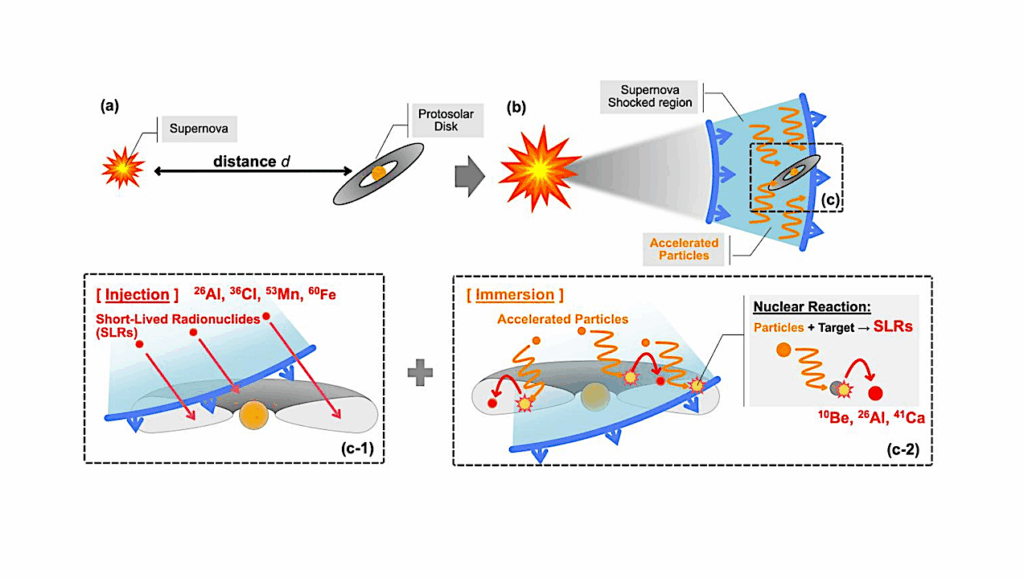Now Reading: Artificial Broadcasts as Galactic Populations: II. Comparing Individualist and Collective Bounds on Broadcast Populations in Single Galaxies
-
01
Artificial Broadcasts as Galactic Populations: II. Comparing Individualist and Collective Bounds on Broadcast Populations in Single Galaxies
Artificial Broadcasts as Galactic Populations: II. Comparing Individualist and Collective Bounds on Broadcast Populations in Single Galaxies


Current and forthcoming constraints on radio line broadcasts in M31 (left) and three example Virgo cluster ellipticals (right), assuming that all broadcasts in each galaxy have the same EIRP ℓ. The G17 observations of M31 exclude the red shaded region, while example future observations with FAST and GBT are in blue and green, respectively. Solid shading applies to individualist constraints when δM = 0, and hatched shading is for the noise confusion limit at high δM (vertical for M49, diagonal for M31 and M87, horizontal for M59). — astro-ph.GA
The search for extraterrestrial intelligence includes efforts to constrain populations of artificial broadcasts in other galaxies.
Previous efforts use individualist methods, searching for single broadcasts with high signal-to-noise ratio. These would be detected as observables with extreme values. This approach is limited to very bright broadcasts and also is subject to confusion, where a large number of broadcasts blend together to form a noise continuum. The mean value of the total emission provides an additional collective bound: the luminosity of the transmitters is no higher than the galaxy’s observed luminosity.
Using the framework developed in Paper I, I evaluate how confusion affects individualist searches. I then compare individualist and collective approaches for radio broadcasts from the Milky Way, M31, and three Virgo Cluster elliptical galaxies. For current observations, confusion blurs narrowband radio broadcasts together in the Virgo ellipticals when there is one broadcast per gigahertz per 1000 stars.
The collective bound implies fewer than ∼106(ℓ⎯⎯⎯⎯/1013W)−1 L-band broadcasts per star gigahertz GHz in the Milky Way and is about 10 and 400 times stronger in M31 and M59, respectively. Applying the collective bound to the far-infrared–radio correlation yields constraints on radio broadcast populations in star-forming galaxies throughout the Universe. The collective bound allows us to rule out large regions of broadcast population parameter space even for distant galaxies. It also imposes constraints on gamma-ray, neutrino, and gravitational-wave broadcasts in the nearest galaxies.
Brian C. Lacki
Comments: Published in ApJ; 48 pages, 8 figures, 5 tables, 4 appendices
Subjects: Astrophysics of Galaxies (astro-ph.GA); Instrumentation and Methods for Astrophysics (astro-ph.IM)
Cite as: arXiv:2405.04651 [astro-ph.GA] (or arXiv:2405.04651v1 [astro-ph.GA] for this version)
https://doi.org/10.48550/arXiv.2405.04651
Focus to learn more
Journal reference: ApJ 966, 183 (2024)
Related DOI:
https://doi.org/10.3847/1538-4357/ad11f1
Focus to learn more
Submission history
From: Brian Lacki
[v1] Tue, 7 May 2024 20:16:21 UTC (984 KB)
https://arxiv.org/abs/2405.04646
Astrobiology, SETI,
Stay Informed With the Latest & Most Important News
Previous Post
Next Post
-
 012024 in Review: Highlights from NASA in Silicon Valley
012024 in Review: Highlights from NASA in Silicon Valley -
 02Panasonic Leica Summilux DG 15mm f/1.7 ASPH review
02Panasonic Leica Summilux DG 15mm f/1.7 ASPH review -
 03From Polymerization-Enabled Folding and Assembly to Chemical Evolution: Key Processes for Emergence of Functional Polymers in the Origin of Life
03From Polymerization-Enabled Folding and Assembly to Chemical Evolution: Key Processes for Emergence of Functional Polymers in the Origin of Life -
 04How New NASA, India Earth Satellite NISAR Will See Earth
04How New NASA, India Earth Satellite NISAR Will See Earth -
 05And Thus Begins A New Year For Life On Earth
05And Thus Begins A New Year For Life On Earth -
 06Astronomy Activation Ambassadors: A New Era
06Astronomy Activation Ambassadors: A New Era -
07SpaceX launch surge helps set new global launch record in 2024





















